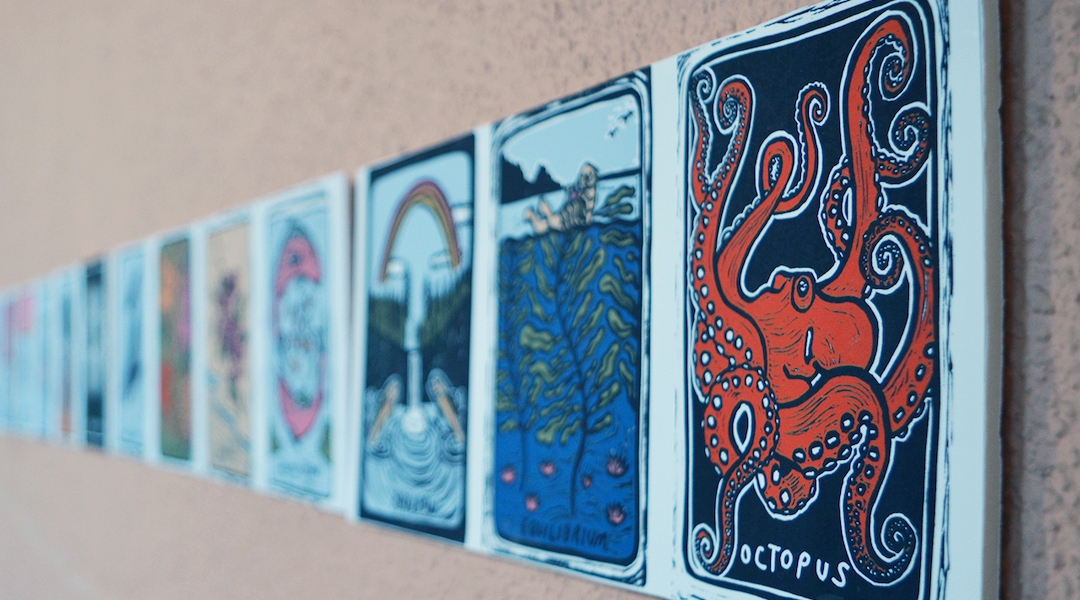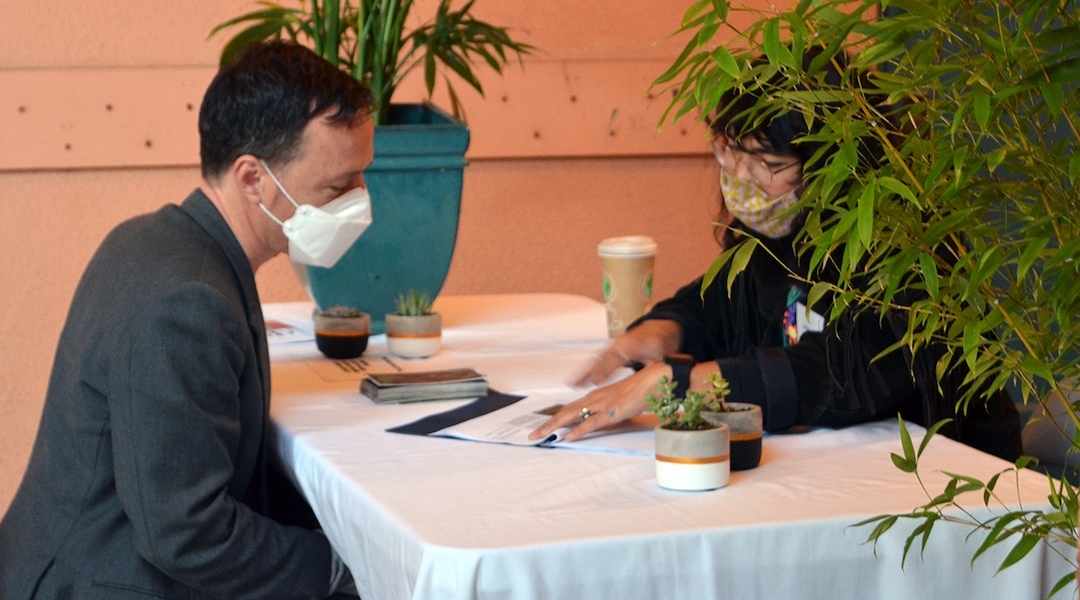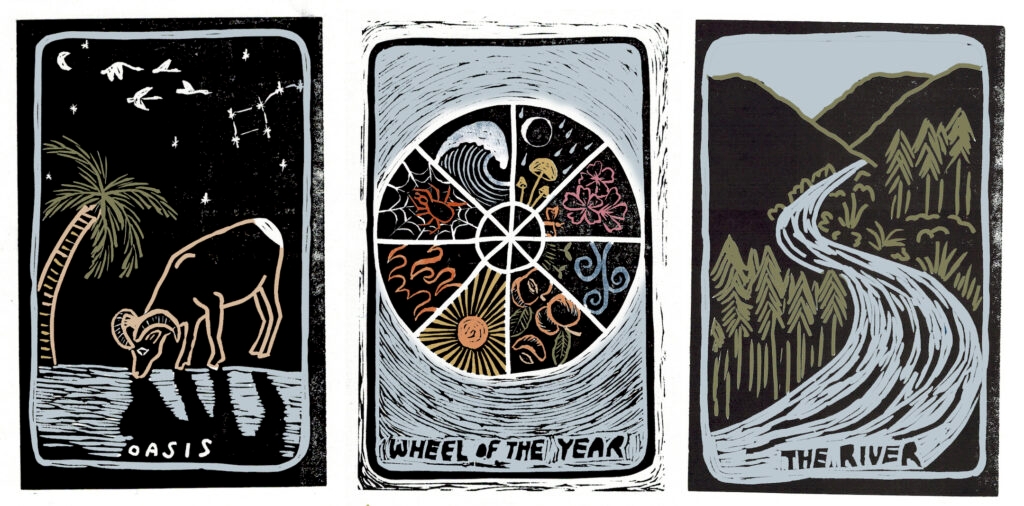(J. The Jewish News of Northern California via JTA) — A wildfire scaling a mountain. A turtle, deep in the earth. A dark sea, rough on the surface and still below.
These images, engraved on blocks and printed by artist Ava Sayaka Rosen, are part of a deck of cards that is part work of art, part spiritual tool, part call to connect with nature.
“I was looking for a way to educate people about ecology, but also to make that connection between caring for the Earth and caring for yourself, and human relationships,” Rosen said. “I felt like the tarot was a good way to fill all those things.”
Rosen, 33, created the tarot deck as a 2021 Fellow with LABA East Bay, the one-year Jewish Artist Fellowship hosted by JCC East Bay in Berkeley, California. It’s a project that merges his passion for nature and text-based art with his Jewish roots.
“My Jewish upbringing, combined with my parents’ love of nature, really instilled a deep sense of belonging and connection to nature,” said Rosen, who is biracial (her mother is Japanese and her father is Ashkenazi Jew). “And that was really the inspiration to make this deck.”
Ava Sayaka Rosen is the artist behind the tarot deck “TARO::TORA”. (Ava Sayaka Rosen)
Rosen, who lives in Oakland, grew up in San Francisco and has a master’s degree in creative writing and book art from Mills College. Her first artistic job was at Congregation Emanu-El as a teenage assistant in the art room, helping the art teacher. Today, she is an artist herself and an art teacher at the San Francisco Synagogue, with her own school-aged Jewish assistants.
“It was my first job and I really enjoyed it,” she said. “And it’s just hilarious to me that I’ve come full circle. I’m out there as an art teacher with teenage helpers.
While her study of the art was in a school setting, her tarot training was personal.
“I was first drawn to the imagery. I didn’t know anything about what the cards meant or their history,” she said. topic, I really got into the practice of tarot reading as a way to investigate myself and my relationships.”
Tarot cards date back to 15th century Italy. They were adapted for mystical purposes, including as a tool for divination, in 18th century France, and social media brought new interest to the practice. During a tarot reading, cards with evocative images are drawn from a deck and interpreted through a particular lens. Some draw on Kabbalah in their readings; other modern Jewish artists have also mixed tarot with Jewish mysticism.

Ava Sayaka Rosen’s Torah-inspired tarot cards on display at LABAlive, an event hosted by JCC East Bay, November 7, 2021. (East Bay Jewish Community)
As an artist, Rosen said creating his own deck was a natural step. The game she designed as a member of LABA is not a particularly Jewish work of art, although it does contain Jewish text to help deepen the understanding of each image. But the LABA grant allowed him to take an existing concept and develop it. It also gave him deadlines to meet.
“It’s a very ambitious project to create original concepts and sculpt them, print them, write them – write the descriptions for them – so I knew I was going to need help with accountability , in a major way,” she said.
Of the 78 cards that make up a tarot deck, Rosen completed 39, mostly during the LABA Fellowship. She plans to look for a publisher once the game is finished.
“That LABA scholarship has really set my ass on fire and given me a deadline, and I’ve just worked very, very hard to produce about half of the game now,” she said.
Never miss a story. Sign up for JTA’s daily email briefing.
SUBSCRIBE HERE
Rosen began each design by drawing a card from his copy of Rider-Waite, the best-known tarot deck (first published in 1909, it is famous for its esoteric imagery and is what most people think of when they think of tarot cards). She let this guide the inspiration and interpretation needed to create her own version.
Reflecting on traditional interpretations of each card, she would find a nature-related concept and create a description with “writing prompts for questions of self-reflection,” she said.
For the Moon card, which shows a bright full moon lightly crowned with clouds, the questions included: What do you know? What are you attracted to? The Compost map guide, which shows glowing mushrooms growing from a log, contains a well-known section from Genesis: “For dust thou art, And unto dust shalt thou return.”
“Working with other Jewish artists has really opened up my ideas about what Jewish art is,” Rosen said.
She called the project “TARO::TORA” after two images from the traditional Rider-Waite game, illustrated by Pamela Colman Smith. “The connection between tarot and Torah, which the title refers to, is mysterious but very present in traditional card archetypes,” she said.
Rosen got to see the power of “TARO::TORA” in person at a live LABA event on Nov. 7 at JCC East Bay. Her corner, where she did readings with her deck, was more popular than she thought.
“I didn’t think a big line would form,” Rosen said with a laugh.
Musician David Israel Katz was one of those who got a reading. He said he was drawn to the project for the way it combined “the visual language of freedom and playfulness on the one hand, and aesthetic cohesion and deep inquiry on the other.” .

Musician David Israel Katz (left) receives a tarot reading from Ava Sayaka Rosen at LABAlive, November 7, 2021. (East Bay Jewish Community)
“As minimal as the reading was in its exterior format, it intimately illuminated the interior,” he told J. in an email. “The map I drew spoke to me right away, and Ava was able to accurately and concisely describe the different facets contained within the image.”
Sarah Wolfman-Robichaud, director of public programs at JCC East Bay, said the JCC was eager to have Rosen in the fellowship not only because of her talent and connections to Jewish art and worlds, but also because of his experience in teaching children. . The JCC plans to expand the LABA by bringing artists into preschool and after-school programs, and Wolfman-Robichaud said Rosen was an obvious choice for that as well.
For Rosen, LABA was a unique opportunity for her to participate in a group with others like her: Jewish artists who together could explore the concepts of Jewishness, art and Jewish art.
“Text study paired with creating art really appealed to me and felt unique,” she said. “It really allowed us to have deep conversations around these ideas and really form a community.”
This story originally appeared in J. The Jewish News of Northern California and is republished with permission.

